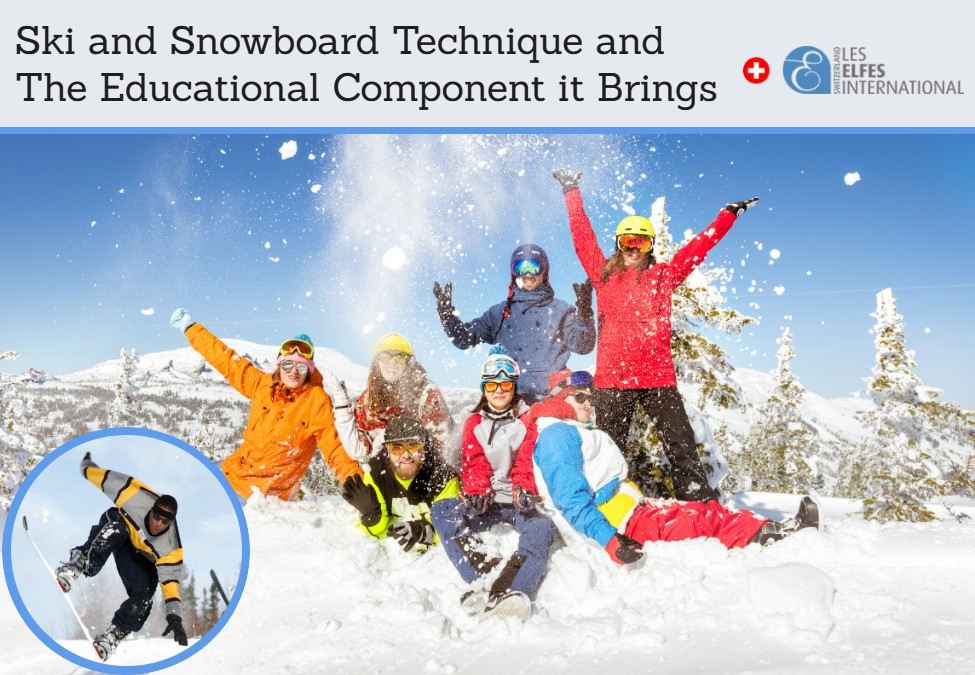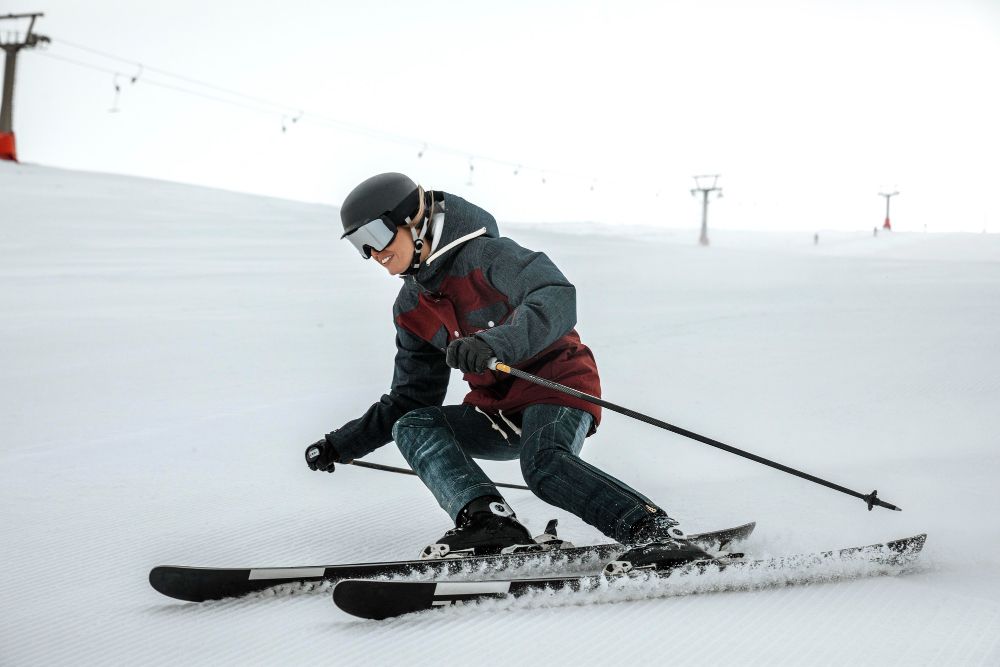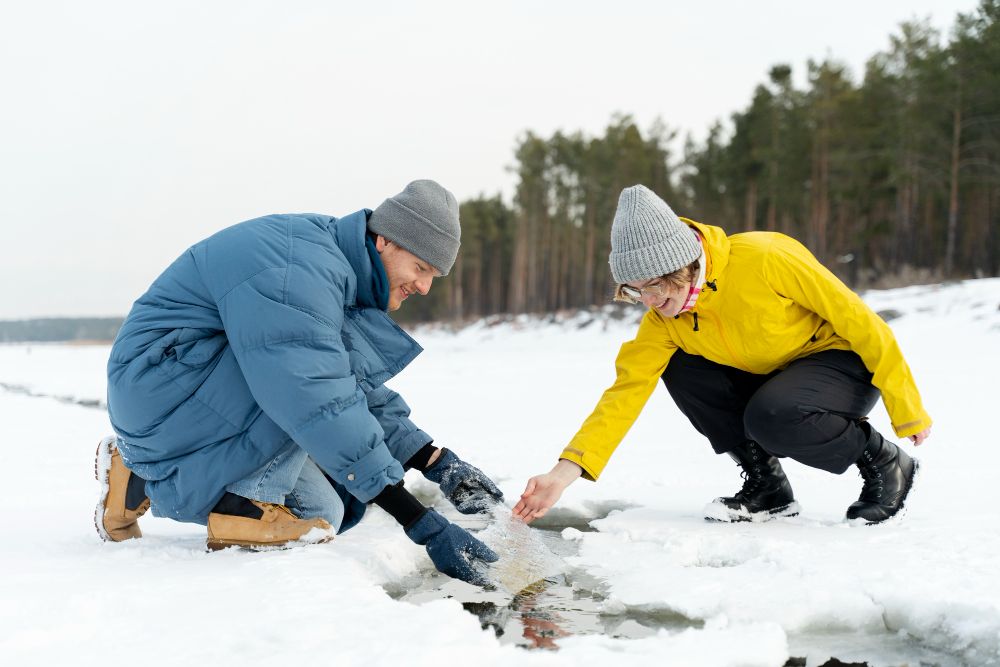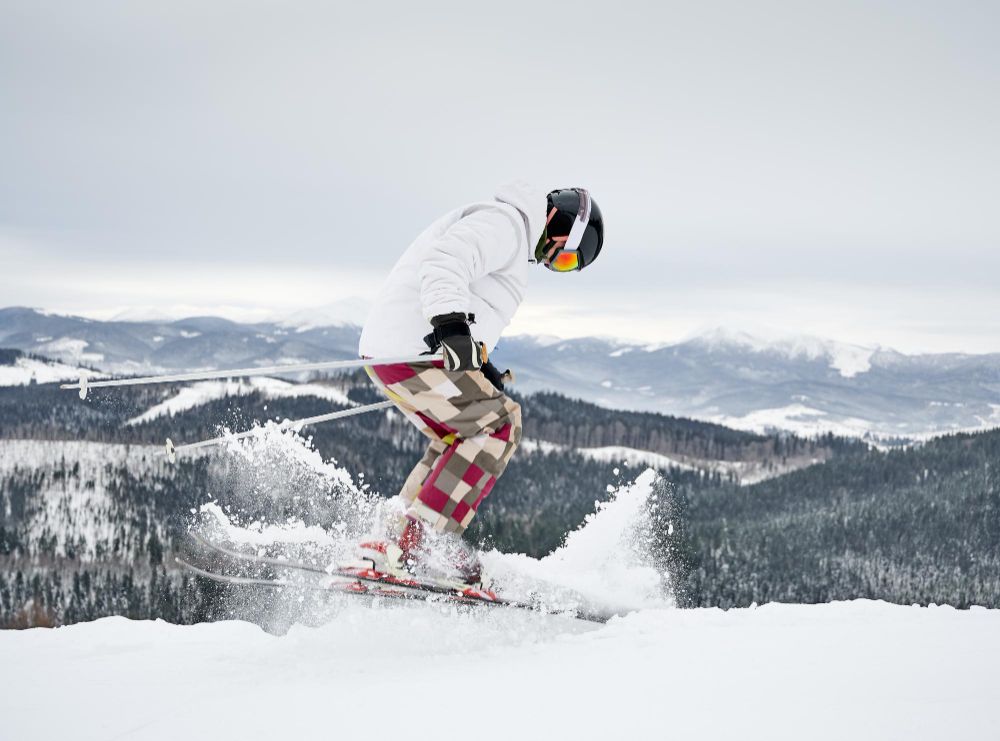Mastering ski and snowboard lessons assures thrilling adventures along the slopes. Further, these snow sports offer various mental and physical advantages. For example, skiing and snowboarding improve muscle strength and cardiovascular health. It also boosts coordination and balance.
Learning snow sports techniques provides the ideal blend of fitness and fun. Whether your child is experienced or a beginner, engaging in ski and snowboarding activities gives them a breathtaking sensation of freedom and speed as they glide down the slopes. Read on to understand the importance of learning ski and snowboarding techniques and its educational impact.
The Importance of Learning the Right Ski & Snowboard Technique
Discovering the ideal ski and snowboard technique is vital for the following reasons.
Injury Prevention
Using the wrong technique can strain a participant’s joints and muscles, resulting in potential injuries and fatigue. On the other hand, the right technique distributes stress evenly on your body, minimizing the risk of wear and tear injuries. Common injuries that the wrong technique may trigger include knee tear or sprain as a result of sudden movements or twisting with the snowboard or skis.
Loss of balance may also cause falls leading to wrist sprains and shoulder fractures. Often, beginners may be in poor form and likely experience coccyx or tailbone injuries due to leaning back when skiing or sitting far off the snowboard.
Further, lower back pain is likely due to improper stance or posture or overly straining the back muscles. To reduce the risk of injuries, professional ski and snowboard trainers must teach kids the correct technique. Conversely, learners should advance their skill level to promote an enjoyable and safer snowsports experience.
How Does Mastering Correct Techniques Can Reduce the Risk of Accidents
Mastering the right techniques in snowboarding and skiing reduces the risk of accidents and injuries along the slopes. Besides boosting balance and control, the correct technique allows snowboarders and skiers to maneuver effectively and react more assertively to sudden situations. With enhanced control, participants reduce the likelihood of collisions with obstacles or other riders.
Learning the ideal technique promotes a deep understanding of snow conditions like moguls, ice, and powder. Individuals can leverage this knowledge to adjust their movements and minimize the risk of losing control and falling.
Skilled snowboarders and skiers are more equipped to navigate challenging terrain. Again, they understand how to safely negotiate narrow turns and handle steeper slopes. Mastering the right technique is crucial to preventing exhaustion. Remember, efficient movements use minimal energy. Fatigue may result in reduced focus and poor decision-making, increasing the risk of accidents.
Enhanced Performance
Proper ski and snowboard technique improves skill, control, and efficiency. It allows snowsports participants to achieve better results with minimal effort, enabling them to ride more confidently for longer. Better control over equipment and movements results in better stability, smoother turns, and precise maneuvers, improving overall slope performance. Further, mastery of technique enables participants to execute advanced tricks and tackle more challenging terrain, broadening the range of achievements and experiences. Eventually, proficiency in ski and snowboard technique encourages individuals to achieve their full potential and enjoy a successful and rewarding snowsports experience.
Understanding the correct ski and snowboard technique improves edge control and body positioning, resulting in better fluidity and speed management. Learning the right technique allows participants to turn smoothly while at high speeds. On the other hand, fluid movements facilitate seamless transitions between manoeuvers and turns, leading to a more controlled and enjoyable ride along the slopes.
Building Confidence
Understanding the correct ski and snowboarding technique offers a solid foundation of control and skills. As skiers and snowboarders master the right techniques, they gain a better sense of balance and stability along the slopes, eliminating the fear of losing control and falling. Of course, more proficiency means participants can effectively navigate different conditions and terrains while managing challenges assuredly. Individual progress and accomplishments encourage skiers and snowboarders to tackle more adventurous experiences while exploring new runs.
Knowing they possess the right skills to manage various situations promotes self-assurance and a positive mindset. This reinforces their confidence. Here is a personal story from an individual who developed their skills and became more self-assured after attending ski and snowboard training sessions.
Interview de Simon Perraudin
Who could better testify to what was just mentioned than Simon, one of the top competitors in the Freeride World Tour 2023? While Simon was part of the team at Les Elfes International Camp, we had the lucky chance to work with him and learn from his impressive experience. In the interview below, Simon shares not just his skiing insights but also some important life lessons. His amazing journey highlights how sports and personal growth go hand in hand, encouraging us to face challenges with the same determination and excitement that he brings to the mountains.
How old were you when you learnt to ski?
I started skiing when I was 2 years old.
In your opinion, how important is it to learn the right skiing technique to become an expert skier?
It’s very important to have a good base so that you can push your limits. Having a good skiing technique means you can feel at ease on steep slopes and stay in control in all circumstances.
What has skiing taught you (e.g. respect for the mountain, team spirit when skiing with others, being responsible)?
Skiing has taught me that you can’t control nature, and that the mountains are still a dangerous place, so it’s important to ski in a group and with the right equipment.
On top of that, skiing has given me lots of friendships and incredible moments.
What sports do you practice when the ski season ends?
I like cliff diving with my friends, whether in Switzerland or further afield, and I also do a bit of enduro and fitness to get ready for winter.
What tips would you like to share with children who are just starting to ski?
You have to be patient because it takes time to improve, but the most important thing is to enjoy yourself and not overestimate your abilities.
And with those who are already experienced skiers?
I think surrounding yourself with good skiers can really help, and sometimes you have to dare to get out of your comfort zone and try new things.
The Educational Component of Ski & Snowboard Training
Ski and snowboard training is vital to learning with these snowsports for beginners and experienced riders. Training provides structured lessons that cover snowboard boots usage, safety, mountain etiquette, and correct techniques. Such educational sessions help individuals to understand the aspects of movements like turning, carving, and stopping. In the end, training makes individuals effective riders.
Skilled instructors personalize training to fit individual abilities. The educational part of ski and snowboard training promotes a robust understanding of snowsports, making way for an enjoyable, safe, and successful snowboarding or skiing journey. Here are the educational aspects that ski and snowboarding training covers.
Understanding Snow and Terrain
Ski and snowboard training incorporates instruction, allowing participants to learn about the types of snow conditions available on the mountain. Further, skiers and snowboarders learn the art of adapting their movements and techniques accordingly to navigate different snow conditions safely.
Training allows participants to understand the terrain and the challenges involved. They learn about inclines, slopes, and possible hazards such as rocks, tree wells, and moguls. Understanding the terrain helps individuals make informed decisions during ski and snowboarding sessions.
They are also well-informed to choose convenient routes and runs matching their skill level.
Les Elfes has put the right measures in place to ensure that campers stay on the right skiing path and don’t go off-piste. Further, the ski conditions in Verbier are quite favorable, guaranteeing each camper’s safety.
Importance of Knowing the Terrain and Its Impact on Technique
Understanding the terrain and figuring out its impact on your technique is crucial for the following reasons.
· Safety
Knowing the terrain helps riders establish potential hazards and challenges, like steep slopes, rocks, moguls, or tree wells. Being aware of these components allows them to make informed decisions, choose the right routes, and adjust their technique to avoid potential risks.
· Progression
Understanding the terrain is crucial for skill progression. As riders become more proficient at tackling different terrains, they gradually progress to more challenging runs while expanding their capabilities.
· Energy Efficiency
Adapting techniques to the terrain improves energy efficiency. For example, maintaining a balanced stance on the slopes and using correct turning techniques can preserve energy while preventing fatigue.
· Proper Choice of Technique
Worth mentioning is that every terrain is different and requires different techniques. For instance, tackling moguls requires impact absorption and fast turns. Riders need excellent edge control to carve on groomed runs. Understanding the terrain enables riders to choose the right techniques to navigate the conditions they may encounter.
· Enhancing Performance
Knowing the terrain enables riders to plan their movements and lines strategically. Of course, this is critical for smoother runs, improved performance, and an enjoyable experience on the slopes.
· Developing Confidence
Being aware of the terrain boosts the riders’ confidence. When they know what to expect and how to tackle it, they feel a sense of self-assuredness and a readiness to handle new challenges.
Weather and Safety Awareness
Ski and snowboard training helps participants understand the possible risks affiliated with changing weather conditions. Often, training sessions incorporate discussions on snow conditions and weather patterns, and how they affect snowsports. Being aware of weather forecasts enables riders to prepare for different conditions like icy patches, snowstorms, and fog.
Training includes safety practices like wearing the right gear, complying with mountain rules, and using avalanche beacons. With this knowledge, participants learn how to be responsible for their safety and that of other riders. Weather consciousness is critical to safety in skiing and snowboarding.
How Can Understanding Weather Conditions Influence Decision-Making on the Slopes?
Knowing weather conditions influences decision-making on the mountain in various ways, as seen below.
· Choice of Terrain
Varying weather conditions impacts the difficulty and quality of the slopes. For example, fresh powder snow requires different techniques as opposed to skiing or snowboarding on icy or packed snow surfaces. Knowing the prevailing weather helps participants choose the right terrain for their preferences and skill level.
· Proper Dressing
Establishing weather conditions enables snowboarders and skiers to dress accordingly. This way, they can wear the appropriate protective gear to remain safe and comfortable along the slopes.
· Avalanche Awareness
Determining the recent weather changes is critical for knowing avalanche risks. Changes in snowfall and temperature often increase the chances of avalanches. In this case, riders should avoid high-risk areas and adhere to avalanche safety practices.
· Safety
Weather conditions have a direct impact on your safety and that of other riders on the slopes. For example, knowing whether there is low visibility, high winds, or snowstorms enables participants to evaluate the potential hazards and risks accordingly. They can choose whether the conditions are safe to engage in snowsports. In severe conditions, the riders may decide to wait for the weather to become friendlier or ride along designated areas.
· Time Management
Weather conditions often affect the timing of snowboarding and skiing sessions. For instance, warmer temperatures during the afternoon often result in icy or slushy slopes. Usually, mornings offer better snow conditions. Knowing the weather helps riders figure out the best time to hit the terrain.
Environmental Awareness
During ski and snowboarding training, participants discover mountain ecology and cover the mild balance of fauna, flora, and human impacts. Trainers emphasize sustainable practices like the use of eco-friendly materials and reducing waste.
Skiers and snowboarders learn how to respect nature and the importance of preserving mountains for future generations. Climate change awareness drives highlighting the relevance of reducing carbon footprints and environmental-based initiatives such as recycling and tree planting are part of the training.
Promoting environmental awareness enables snowboarders and skiers to become proponents of creating an environmentally aware snowsports community, protecting the mountain’s natural beauty, and sustainability.
Importance of Respecting the Natural Environment in Ski Resorts
Respecting the natural environment facilitates the conservation of unique wildlife and ecosystems, maintaining pure mountain landscapes for future generations to enjoy. The implementation of sustainable practices like responsible waste management and energy conservation reduces the ecological footprint at the ski resort.
Encouraging eco-friendly initiatives is crucial for the long-term growth of snowsports. Conserving natural beauty improves the overall experience at the resort, benefiting the local economy and community.
How Can Sustainable Practices Help Preserve the Mountains for Future Generations?
Besides being delicate ecosystems with unique cultural significance and biodiversity, mountains are vulnerable to the effects of human activity and climate change. However, adopting sustainable practices can help reduce the human ecological footprint while ensuring the long-term viability and health of these landscapes. These practices include:
· Cutting Down on Carbon Footprint
Using energy-efficient technologies, renewable energy sources, and encouraging eco-friendly transportation facilitates the reduction of greenhouse gas emissions. By mitigating human carbon footprint, humans slow down climate change which can adversely affect mountain ecosystems, triggering a change in weather patterns, glacial retreat, and increasing the risk of wildfires.
· Responsible Use of Resources
The efficient use of resources, reducing waste, and recycling of materials facilitate the reduction of pressure on mountain ecosystems. For instance, ski resorts can adopt water preservation practices to safeguard local water sources while maintaining a stable ecosystem for wildlife.
· Conservation of Biodiversity
Mountains host diverse animal and plant species. Often, some of these are either endemic or endangered. Restricting development and safeguarding natural habitats is crucial for conserving biodiversity. Doing so retains unique and rich wildlife for future generations to appreciate.
· Reduced Pollution
Sustainable practices are meant to reduce pollution in the water and air. Ski resorts can adopt sustainable snowmaking techniques that utilize less water while reducing air pollution. Conserving water and air quality helps protect the health of the mountains and the people that depend on them.
· Protecting Cultural Heritage
Often, mountains hold remarkable historical and cultural value for local communities. Sustainable applications ensure that development adheres to traditional and cultural heritage protocols. Promoting sustainable tourism is crucial to conserving the cultural identity associated with these ecosystems and supporting local communities.
· Increased Resilience
Sustainable practices nurture ecological resilience, enabling mountain ecosystems to recuperate from disturbances while adapting to developing conditions effectively. Through this resilience, mountains can bear the effects of climate change.
The Role of Proper Instruction
Proper instruction impacts skill development and learning in ski and snowboard technique training. Safety is one of the core components. Trainers ensure that learners understand the vital safety practices and guidelines, reducing the risk of accidents leading to injuries on the slopes. The professionals train students on the proper use of equipment, how to watch out for potential hazards, and complying with mountain rules, creating a safe environment for everyone involved.
Again, technique plays a major role in proper instruction. Trainers provide essential insights to ensure learners understand the right snowboarding and skiing techniques. Learning the rough movements and form enables riders to effectively regulate their actions, enhance their performance, and acquire confidence in their abilities.
Promoting Skill Progression
Further, proper instruction promotes skill progression. Trainers provide a structured learning concept that enables participants to advance at their own pace. They offer applicable exercises and challenges, gradually relying on the learned skills and enabling participants to progress to more complex terrain and manoeuvers.
Instructors ensure participants are conversant with different snow conditions and slopes. They train them to adapt their technique to different terrains. Knowing the terrain and its effects on snowboarding and skiing helps participants make informed decisions and maintain safety on the mountain.
Providing individualized feedback is a crucial part of proper instruction. Skilled instructors give personalized guidance and feedback tailor-made to each individual’s area of improvement and strengths. Participants can rely on this feedback to recognize and correct mistakes, resulting in efficient learning and skill development.
Building Participants’ Confidence
As learners master the right techniques and advance their abilities, they become more self-assured. This empowers them to explore new challenges while facilitating enjoyment in the sport. As seen above, instruction often incorporates education on the natural environment, helping learners understand why they should respect it during snowsports. This promotes environmental awareness while encouraging responsible behavior on the mountains.
Importance of Professional Guidance
Professional guidance from certified instructors is important in skiing and snowboarding for various reasons, including.
· The Right Technique
Professional and certified instructors have comprehensive snowboarding and skiing techniques knowledge. They can easily recognize and correct movements and form posture mistakes, enabling participants to develop the ideal skill from the word go. Mastering the proper technique improves performance and control, developing confidence on the slopes.
· Safety
Every professional instructor has undergone stringent training to train snowsports safely. They are conversant with equipment usage, slope safety, and risk management. Their proficiency ensures that individuals learn and adhere to appropriate safety protocols, reducing the risk of accidents and injuries.
· Personalized Instruction
A certified instructor offers personalized instruction tailor-made to fit every participant’s goals and skill level. An individualized approach enables learners to receive targeted feedback, facilitating continuous improvement. They also learn gradually.
· Efficient Learning
Receiving professional guidance plays a core role in accelerating the learning process. Certified instructors leverage progressive lesson plans and effective training methods. Doing so optimizes the time learners spend on the slopes to maximize skill development.
· Condition and Terrain Expertise
Ski and snowboarding professional trainers are conversant with reading snow conditions and determining terrain features. They can guide participants, ensuring they adapt their technique to different weather conditions and slopes. Of course, this enhances their ability to navigate terrains safely.
How Does Personalized Guidance Accelerate Learning and Improve Skills?
Personalized guidance speeds up learning while improving ski and snowboarding skills in the following ways.
· Targeted feedback
Instructors provide individualized feedback based on each participant’s strengths while highlighting where to improve. Determining and addressing areas of concern helps individuals adjust their technique accordingly, facilitating fast progress.
· Individualized Lesson Plans
Through personalized instruction, trainers can develop lesson plans that match the learner’s goals and skills. Whether you’re an experienced rider seeking to refine your technique or a beginner learning the basics of snowsports, these lesson plans cater to the distinct needs of every participant.
· Adaptive Instruction
Learners have different needs and skill levels. Instructors can adapt their training approach and style to fit the learning abilities and preferences of every participant. Doing so ensures that learners receive instructions in the best way that resonates with their needs.
· Banking on Existing Skills
Personalized guidance identifies and relies on the learner’s existing knowledge and skills. The instructor can utilize this basis to introduce new approaches and advance the participant’s abilities effectively.
· Support and Encouragement
Personalized guidance promotes a motivating and supportive learning environment. Trainers provide support and encouragement, increasing the learner’s confidence and willingness to try new challenges.
· Real-Time Adjustments
An instructor can execute real-time adjustments between lessons depending on the individual’s understanding and performance. Doing so ensures that learners master the concepts before proceeding, optimizing their learning experience.
· Goal-Oriented Learning
Instructors collaborate with learners to set clear yet achievable goals. The personalized approach plays a great role in enabling participants to remain motivated and focused. Eventually, achieving their goals grants them a sense of accomplishment.
Utilizing Technology and Video Analysis
Modern technology has been instrumental in improving ski and snowboard techniques, improving the learning experience and general performance on the mountains. Here is the impact of technology on snowsports.
· Video Analysis
High-quality video playback and recording technology enables instructors to capture learners’ movements in the mountains. It is critical for self-improvement and helps participants learn from their mistakes. Further, it provides immediate insights, visual feedback, and objective performance evaluation.
Learners can leverage video analysis to visualize their technique, recognize areas that require improvement, and obtain targeted feedback. This speeds up skill development. Moreover, participants can establish potential errors, compare with their trainers, and set distinct goals. Watching successful runs strengthens muscle memory while motivating progress.
· Ski and Snowboard Apps
Numerous mobile applications offer real-time feedback, training plans, and coaching tips during ski and snowboarding sessions. They can track performance metrics such as turns and speed, helping participants observe their progress and make data-oriented improvements.
· Virtual Reality
Virtual reality technology gives learners immersive training experiences, simulating snowboarding and skiing conditions. This allows learners to practice different techniques within a controlled environment, improving confidence and motor memory before hitting the mountains.
· Motion Tracking Gadgets
Wearable motion monitoring gadgets like fitness trackers and smartwatches can record ski and snowboard movements. These gadgets enable trainers and learners to study performance metrics like elevation, distance, and speed. This facilitates the learner’s self-assessment and improvement.
· Ski and Snowboard Simulators and Equipment Innovations
State-of-the-art simulators recreate the ski and snowboard sensation indoors. Beginners can leverage these simulators to build essential skills and motor memory before attempting them on the slopes. Today, ski and snowboard equipment are available in varying materials and designs. High-performance gear improves maneuverability, control, and stability, enabling riders to enhance their technique.
· Online Learning Platforms and Resort Technology
Learners can access instructional webinars, tutorials, and videos from professional athletes and certified instructors. Online resources offer valuable training tips and insights for skiers and snowboarders of different skill levels. Many resorts today have integrated advanced technology for avalanche control, snow grooming, and lift systems, guaranteeing efficient and safe mountain operations.
Conclusion
Learning the correct ski and snowboard technique is vital for growth, enjoyment, and safety in snow sports. The proper technique lowers the risk of accidents and injuries in the mountains, ensuring safety for the participants and other people on the terrain. Furthermore, grasping the correct techniques improves speed management, performance, and movement fluidity. This results in an enjoyable and controlled ride along the slopes.
The educational component of skiing and snowboarding is vital. Certified trainers impart valuable knowledge and skills regarding terrain awareness, mountain safety, and environmental responsibility. Investing in proper education and training encourages mindful and responsible practices, appreciating the natural environment, and conserving the mountains for future generations.
Are you planning to enroll your child in a ski and snowboard training session? Collaborate with a professional and certified instructor to accelerate their learning process. Mastering ski and snowboard techniques helps your child participate in adventurous snowsports, making the most of their winter break.
Image Credit:
- Image by Freepik
- Image by Freepik
- Image by Freepik
- Image by ArtPhoto_studio on Freepik













